Admiral ATW4475XQ, ETW4400XQ, ITW4300XQ, IV4500X, IV4600X Owner's Manual
...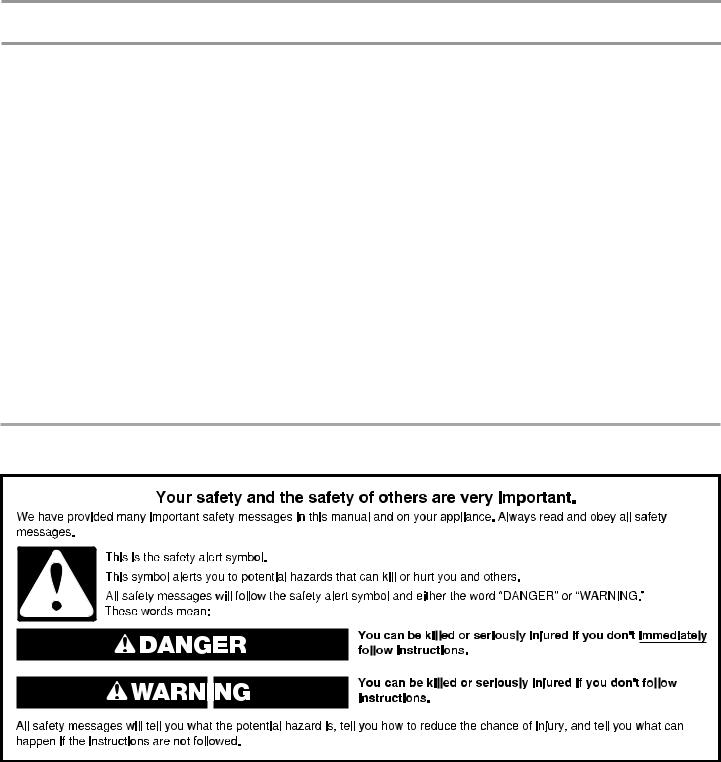
WASHER |
INSTRUCTIONS |
USER INSTRUCTIONS |
D’UTILISATION |
|
DE LA LAVEUSE |
Para una version de estas instrucciones en español, visite www.whirlpool.com
Table of Contents |
|
Table des matières |
||
WASHER SAFETY............................................................. |
1 |
SÉCURITÉ DE LA LAVEUSE.......................................... |
10 |
|
ACCESSORIES................................................................. |
2 |
ACCESSOIRES............................................................... |
11 |
|
USING LESS WATER AND ENERGY............................... |
2 |
RÉDUCTION DE LA CONSOMMATION D’EAU |
||
CONTROL PANEL AND FEATURES................................ |
3 |
ET D’ÉNERGIE................................................................ |
11 |
|
CYCLE GUIDE................................................................... |
4 |
TABLEAU DE COMMANDE |
12 |
|
WASHER USE |
5 |
ET CARACTÉRISTIQUES............................................... |
||
GUIDE DE PROGRAMME |
13 |
|||
WASHER CARE |
6 |
|||
UTILISATION DE LA LAVEUSE |
14 |
|||
TROUBLESHOOTING |
7 |
|||
ENTRETIEN DE LA LAVEUSE |
16 |
|||
WARRANTY |
9 |
|||
DÉPANNAGE |
17 |
|||
ASSISTANCE OR SERVICE |
Back Cover |
|||
GARANTIE |
19 |
|||
|
|
|||
|
|
ASSISTANCE OU SERVICE..................... |
Couverture arrière |
|
WASHER SAFETY
W10347263B |
W10368956B-SP |

ACCESSORIES
Enhance your washer with these premium accessories.
For more high-quality items or to order, call 1-800-901-2042, or visit us at www.whirlpool.com/accessories.
In Canada, call 1-800-807-6777 or visit us at www.whirlpoolappliances.ca
Part Number |
Accessory |
1903WH |
Laundry supply storage cart |
8212526 |
Washer drip tray, fits under all |
31682 |
All purpose appliance cleaner |
Using Less Water and Energy
This washer is designed to use less water and energy, and complies with all 2011 energy standards. Wash cycles with controlled temperatures are designed to maintain cleaning performance while using less water and energy compared to older traditional washers. As a result, water levels will be lower, and hot and warm wash temperatures may not be as warm as you are used to.
Traditional |
Reduced water |
washer |
washer |
2
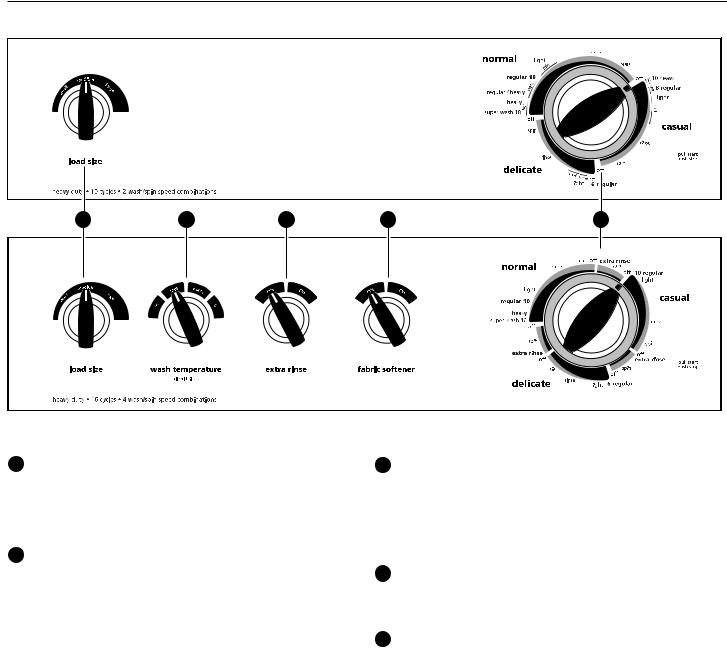
CONTROL PANEL AND FEATURES
This Use and Care Guide covers several different models. Not all models are shown.
Not all features and options are available on all models. Appearance may vary.
1 |
2 |
3 |
4 |
5 |
1Load Size Control
Use this option to adjust the amount of water used with your load size. Use enough water to allow the load to move freely. NOTE: The highest water level will be lower than that of pre-2011 washers.
2Wash Temperature Control
Wash Temperature Control senses and maintains uniform water temperatures by regulating incoming hot and cold water.
■■Warm and hot water will be cooler than what your previous washer provided.
■■Even in Cool wash, some warm water is let into washer to maintain a consistent minimum temperature.
NOTE: On some models, the wash temperature is determined by the selected wash cycle.
Select a wash temperature based on the type of fabric and soils being washed. For best results, follow the garment label instructions, using the warmest wash water safe for your fabric. See “Wash Temperature” Chart.
NOTE: In wash water temperatures colder than 60° F (15.6° C), detergents do not dissolve well and soils can be difficult to remove.
3Extra Rinse (on some models)
If you desire an extra rinse at the end of your regular cycle, turn the Extra Rinse knob to ON.
On models without the Extra Rinse knob, choose a second rinse by pushing the Cycle Control knob in and rotating it to any of the “Rinse” cycle settings.
4Fabric Softener (on some models)
If using fabric softener, set to ON to ensure proper dispensing of fabric softener.
5Cycle Control knob
Select the wash cycle best suited for your type of fabric. See “Cycle Guide” for more details.
3
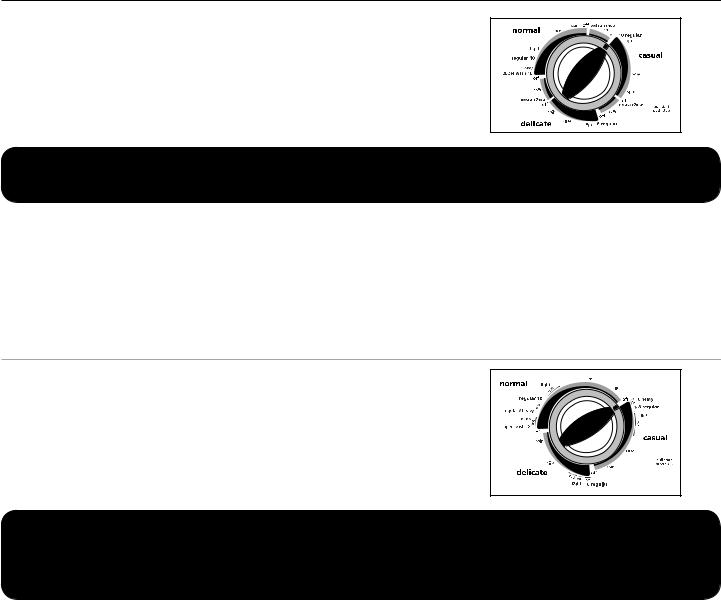
CYCLE GUIDE
For models with a separate Wash Temperature control knob.
Not all cycles or options are available on all models.
Refer to the cycle control knob on your washer.
Wash temperatures are selected using the Wash Temperature knob. Refer to the Wash
Temperature Guide below for recommendations on selecting a wash temperature.
|
Soil |
Wash/Spin Speed |
Wash |
|
|
||
Types of Fabric |
4-speed |
|
2-speed |
Cycle |
Cycle Details: |
||
|
|||||||
Level |
Combinations† |
|
Combinations |
Time* |
|||
Cotton and |
Moderate |
High/High |
|
High/High |
6 - 16 |
Normal |
A wash time should be selected based |
linen fabrics |
to Heavy |
|
|
|
|
|
on the soil level of your load. |
|
|
|
|
|
|
|
|
Permanent press |
Light to |
High/Low |
|
High/High |
6 - 10 |
Casual/ |
Features a cool down rinse and |
blends and |
Moderate |
|
|
|
|
Permanent |
low-speed† final spin to reduce wrinkling. |
synthetic fabrics |
|
|
|
|
|
Press |
|
|
|
|
|
|
|
|
|
Delicate items and |
Light to |
Low/Low |
|
Intermittent |
4 - 6 |
Delicate/ |
Gently removes soils and minimizes |
washable knits |
Moderate |
|
|
High/High |
|
Gentle Wash |
wrinkling. |
|
|
|
|
|
|
|
|
* Approximate time in minutes.
† Not on all models.
For models without a separate Wash Temperature control knob.
Not all cycles or options are available on all models.
Refer to the cycle control knob on your washer.
All cycles feature a high-speed agitation and high-speed spin.
Wash temperature is selected with the cycle control knob. Refer to the Wash
Temperature Guide below for recommendations on selecting a wash temperature.
|
Soil |
Wash |
|
|
Types of Fabric |
Level |
Time* |
Cycle |
Cycle Details: |
|
|
|
|
|
Cotton and |
Super Wash |
18 |
Normal |
A wash time should be selected based on |
linen fabrics |
Regular |
10 |
|
the soil level of your load. |
|
Light |
8 |
|
|
|
|
|
|
|
Permanent press |
Heavy |
10 |
Casual |
Features a cool down rinse and a shorter |
blends and |
Regular |
8 |
|
final spin to reduce wrinkling. |
synthetic fabrics |
Light |
6 |
|
|
|
|
|
|
|
Delicate items and |
Regular |
6 |
Delicate |
Gently removes soils and minimizes |
washable knits |
Light |
4 |
|
wrinkling. |
|
|
|
|
|
*Approximate time in minutes. Once desired water level and wash temperature has been reached, push in and turn Cycle Control knob to select desired wash time.
Wash Temperature Guide
Wash Temperature |
Suggested Fabrics |
|
|
Hot (on some models) |
Whites and pastels, durable garments, heavy soils |
Some cold water is added to save energy. This will be cooler |
|
than your hot water heater setting. |
|
|
|
Warm |
|
Some cold water will be added, so this will be cooler than what |
Bright colors, moderate to light soils |
your previous washer provided. |
|
|
|
Cool - brights/darks |
|
On some models, warm water is added to assist in soil removal |
Colors that bleed or fade, light soils |
and to help dissolve detergents. |
|
|
|
Cold |
Dark colors that bleed or fade, light soils |
This is the temperature from your faucet. |
|
|
|
4
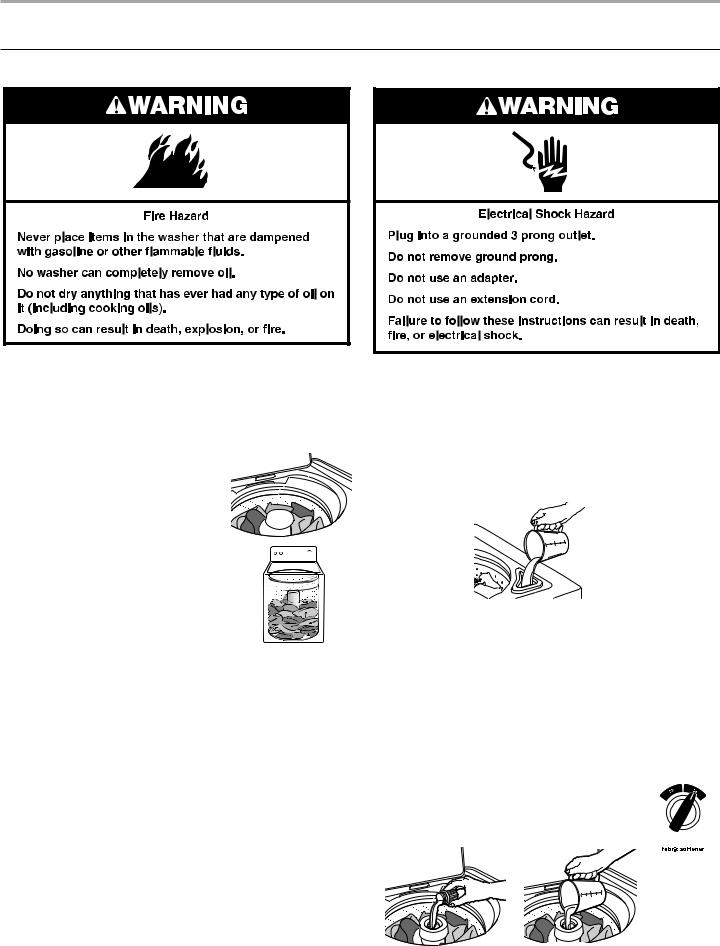
WASHER USE
STARTING YOUR WASHER
IMPORTANT: When washing any article of clothing, always follow fabric care labels and manufacturer’s directions.
1.Measure detergent and add to the bottom of the washer. If desired, add oxi or color-safe bleach products to the bottom of the washer as well.
2.Loosely add sorted load of clothes to wash basket.
■■ Load evenly to maintain washer balance.
■■ Mix large and small items. 









 ■■ Use garment bags for smaller items
■■ Use garment bags for smaller items 






Do not wrap large items such as sheets around the agitator. Items need to move freely for best cleaning and to reduce wrinkling and tangling.
3.Add only liquid chlorine bleach to the dispenser. Bleach is immediately added into the washer and is diluted automatically during the wash cycle.
NOTE: Do not use this dispenser to add powdered chlorine or color-safe bleach to your load.
Style 1: Without liquid chlorine bleach dispenser (on some models):
■■ Let the washer fill and begin agitating the load.
■■ Add bleach 5 minutes into the wash cycle for best dispensing. Pour bleach around the agitator. Take care not to pour bleach directly onto the load to avoid damaging clothing or other items in the load.
Style 2: With liquid chlorine bleach dispenser (on some models):
■■ Using a cup with a pouring spout, measure amount of bleach. Do not allow bleach to spill, splash, drip, or run into the basket or on load. Do not use more than the recommended amount.
NOTE: Undiluted bleach will damage any fabric it touches. Damage may appear several washings later as rips, tears, holes, and color loss.
4.Add liquid fabric softener to dispenser. Fabric softener is added automatically during the final rinse cycle.
Style 1: With liquid fabric softener dispenser (on some models):
■■ Measure recommended amount of liquid fabric softener. Do not allow liquid fabric softener to spill, splash, drip, or run into the basket or on load. Do not use more than the recommended amount.
■■ Always dilute liquid fabric softener by filling the dispenser with warm water until reaching the Max Fill Line arrows. Undiluted fabric softener can stain fabrics.
■■ On models with a Fabric Softener selector knob, turn the knob to the ON position to ensure proper dispensing.
5
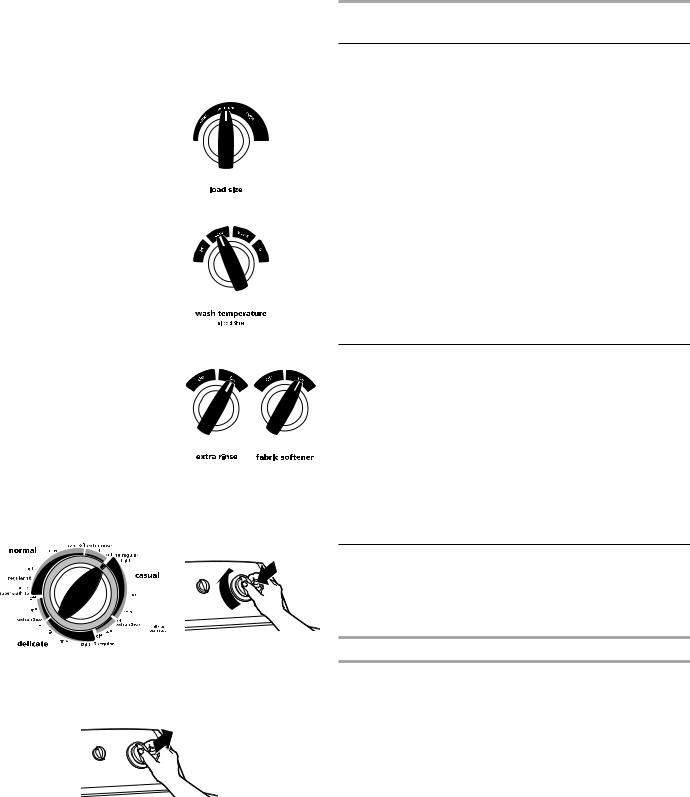
Style 2: Without liquid fabric softener dispenser (on some models):
■■ In the final rinse only, add fabric softener that has been mixed thoroughly with 1 quart (1 L) warm water.
5. Close the washer lid. Washer will not operate with lid open.
6. Select Load Size.
7. On models with a separate Wash Temperature knob, select the desired wash temperature.
8. Select Extra Rinse and Fabric Softener options (on some models), if desired.
9.Select Cycle.
Push the Cycle Control knob in and turn clockwise to the cycle you want.
WASHER CARE
Cleaning Your Washer
Use a soft, damp cloth or sponge to wipe up any spills such as detergent or bleach from the outside of your washer.
Clean your washer interior by mixing 1 cup (250 mL) of chlorine bleach and enough detergent to equal twice the manufacturer’s recommended amount for a normal wash load. Pour this mixture into your washer and run it through a complete cycle using hot water. Repeat this process if necessary.
Remove any hard water deposits using only cleaners labeled as washer safe.
Cleaning the liquid fabric softener dispenser
(on some models)
1.Remove dispenser by grasping top with both hands and squeezing, while pushing upward with thumbs.
2.Rinse dispenser under warm water, then replace it.
NOTE: To avoid damage to the washer or clothing, do not wash clothes with the liquid fabric softener dispenser removed.
Water Inlet Hoses
This washer does not include water inlet hoses. Use of factory specified parts is recommended. See “Accessories” for a list of factory specified hoses available for separate purchase. These hoses are manufactured and tested to meet the manufacturer’s specifications.
Replace inlet hoses after 5 years of use to reduce the risk of hose failure. Periodically inspect and replace inlet hoses if bulges, kinks, cuts, wear, or leaks are found.
When replacing your inlet hoses, mark the date of replacement on the label with a permanent marker.
10.Start the washer by pulling out the Cycle Control knob.
■■ To stop at any time, push in the Cycle Control knob.
■■ To restart, close the lid and pull out the Cycle Control knob.
Moving and Storage
Because some water may stay in the hoses, freezing can damage your washer. If storing or moving your washer during freezing weather, winterize it.
Winterizing your washer
1.Shut off both water faucets. Disconnect and drain water inlet hoses. Pour 1 qt (1 L) of R.V.-type antifreeze into the basket.
2.Run washer on a drain and spin setting for about 30 seconds to mix the antifreeze and remaining water.
3.Unplug washer or disconnect power.
6
